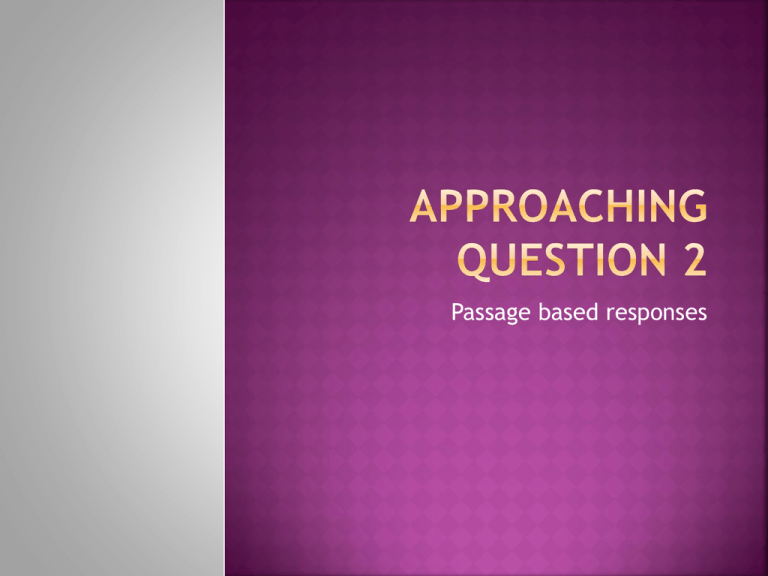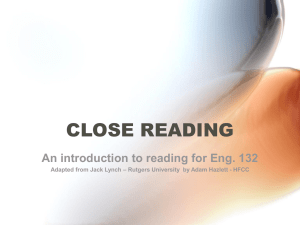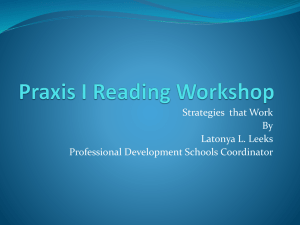Approaching question 2
advertisement

Passage based responses The tone of a passage is key to understanding the meaning- Beware- tones may shift! Tone is also called “the attitude of the speaker” or “the attitude of the narrator” or even the “author’s attitude toward the ….” Tone is mostly created by diction and syntax. Determine tone before you begin- author’s techniques are chosen to achieve the desired tone. In the following passage from Cormac McCarthy’s novel The Crossing (1994), the narrator describes a dramatic experience. In the following passage from The Spectator (March 4, 1712), the English satirist Joseph Addison creates a character who keeps a diary. The passage below is taken from the novel Tom Jones (1749) by the English novelist and playwright Henry Fielding. In this scene, which occurs early in the novel, Squire Allworthy discovers an infant in his bed. In the following excerpt from a recent British novel, the narrator, a young man in his early twenties, is attending a play with his new girlfriend Isabel when she unexpectedly discovers that her parents are in the theater. In the following passage from Cormac McCarthy’s novel The Crossing (1994), the narrator describes a dramatic experience. Read the passage carefully. Then in a well-organized essay, show how McCarthy’s techniques convey the impact of the experience on the main character. In the following passage from The Spectator (March 4, 1712), the English satirist Joseph Addison creates a character who keeps a diary. Read the passage carefully. Then, in a well-organized essay, analyze how the language of the passage characterizes the diarist and his society and how the characterization serves Addison’s satiric purpose. You may wish to consider such elements as selection of detail, repetition, and tone. The passage below is taken from the novel Tom Jones (1749) by the English novelist and playwright Henry Fielding. In this scene, which occurs early in the novel, Squire Allworthy discovers an infant in his bed. Read the passage carefully. Then, in a well-organized essay, analyze the techniques that Fielding employs in this scene to characterize Mr. Allworthy and Mrs. Deborah Wilkins. In the following excerpt from a recent British novel, the narrator, a young man in his early twenties, is attending a play with his new girlfriend Isabel when she unexpectedly discovers that her parents are in the theater. Read the passage carefully. Then write an essay in which you analyze how the author produces a comic effect. The universal is narrowed to the world of literature and the art or craft of creating an effect ( meaning) with words FOR EXAMPLE: “Authors often create characters whose motives are ill defined” “In Literature the reader is expected to recognize patterns that contribute to the meaning of a text or passage.” The universal idea – Themes in literature often center around….. The The context- in this passage by …… thesis- The author’s use of rhetorical devices illustrate…. ( it is not necessary to list the techniques you will discuss) THE WHAT= THE CLAIM - Begin with the ones you notice first! Progress through the passage from there! What techniques are used in this passage for effect? **** you are not limited to those mentioned in the prompt! THE HOW= DATA/ EVIDENCE – WOW! How is this technique used in this particular passage? Are there shifts in the technique? Quotes and explanations to prove you claim. THE WHY/ OR HOW= THE COMMENTARY-WOW! Why/or how is this technique effective at getting across the author’s point? Diction Syntax Figurative language- metaphor etc Structure Characterization Point of view Tone Satirical devices- hyperbole etc. Imagery Selection of detail Narrative pace Repetition Dialogue Internal monologue Why does this author use polysyllabic wordsto create what effect? Why does the author vary the narrative pace in paragraph 2? How does the cumulative sentence in this particular part of paragraph 3 affect the reader? How does the metaphor in paragraph 1lead the reader to an understanding of the character’s fears?








